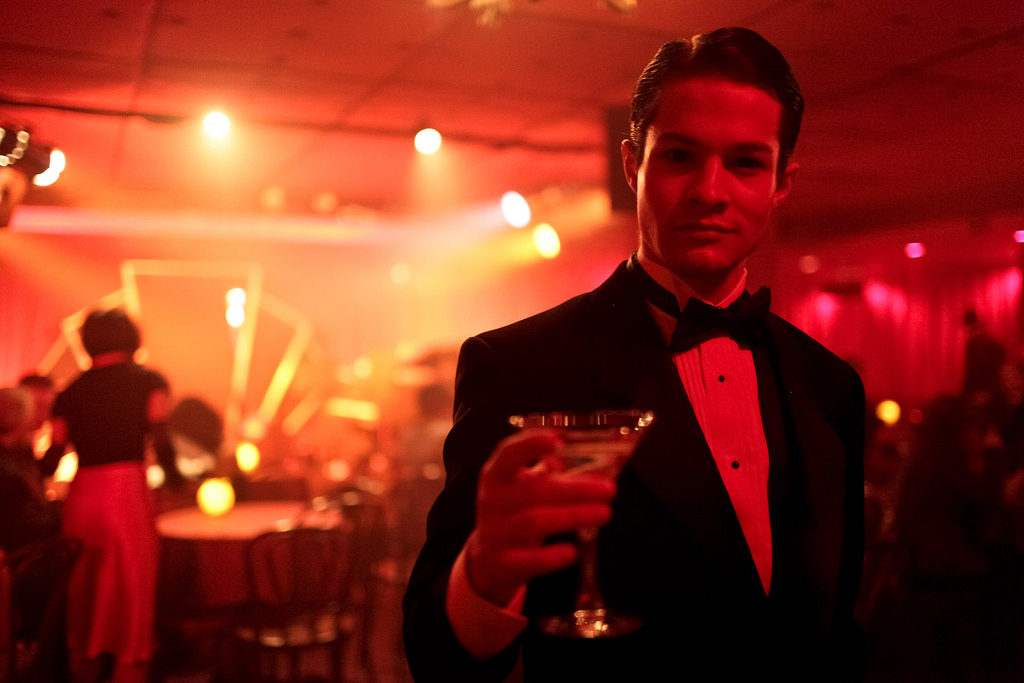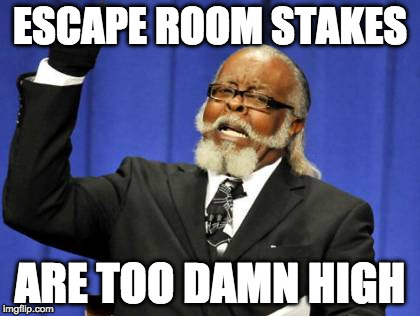Last week, I examined the Meisner technique for the immersive actor. I am particularly excited by the genre’s promise of a scene partner who has no script. Who is, by the way, you. You’re my scene partner.
In immersive theatre, the audience becomes actors. Think of them that way. When sold out, The Man From Beyond has a cast of 10. It’s precisely this radical reconception of the audience that energizes immersive theatre. Hell, I love it so much, I extended Meisner language to include the audience and enshrined it in the Strange Bird mission statement:

But if audiences are truly actors, then they are now facing the same pitfalls all actors do. The audience doesn’t need to worry about not listening—they are hearing the script for the first time—but they do need to overcome the bigger demon: feeling self-conscious.
Most folks associate interactive theatre with self-consciousness, and with good reason. Performances that pull an audience member on stage typically thrive off that person feeling awkward. The performer points up the audience member’s behavior, and the audience subsequently laughs at that person’s expense. This is the stuff of nightmares. This is the OPPOSITE of immersive theatre. Let’s run as far away from that kind of “interaction” as possible.

Training audiences to be in-the-moment like actors are trained isn’t possible, but what we can do is design environments that engender real interaction. Armed with an understanding of the Meisner technique, designers can help slay self-consciousness for audience-actors, so they, too, can live truthfully in imaginary circumstances.
Here are my Meisner-inspired design principles for killing self-consciousness and eliciting truthful behaviors from your audience…
- Make your world rich
- Start your world as soon as possible
- Limit audience watching audience
- Stakes
- Dialogue that matters
- Really doing stuff
- The element of surprise
Make your world rich
Children have no trouble with imaginative play. The entire world still feels novel to them, so behind a bush is as rich a secret hangout as the fanciest speakeasy with trick-wall entrance. But adults must preserve their dignity and need much more help to get them to a point of make-believe. And make no mistake, make-believe is our ultimate goal.
The less your audience has to imagine, the easier it is for them to believe. Immersive actors can help tremendously—they belong to the world, so interacting with them requires adopting their world—but production design also plays a major part. The more you can WOW your audience with a sense that they have been transported, the more they actually have been transported and can act in that world with ease. If you do your job right, they won’t even realize they’re making believe.
Do you have to have a big-budget build-out? No, of course not. While I don’t know of any immersive productions that have done so, you can ask your participants to use their imaginations like black box productions do, but you risk losing a few people in that leap. It’s just easier for me to behave like I’m in a hospital if it looks like a hospital.
Start your world as soon as possible
No matter what you do, there will always be an awkward transition from real world to imaginary world. The earlier your participants can pass through that transition, the easier it will be for them to believe.
I think escape rooms in particular suffer from starting their worlds way too late. You spend a good 15-20 minutes checking in, signing waivers, chatting up the gamemaster, hearing the rules of the game, getting the lock tutorial (oh lord), and then, THEN you cross the threshold to your exciting Egyptian Tomb adventure. No one really expects me to start acting like a cursed archaeologist now, do they? After treating it as a game for so long, I’d feel silly, and making that transition to play-acting would make me feel self-conscious. So I just don’t do it.
(Note that this is where actors inside the game can really help. Escape rooms with actors are the only times I’ve felt motivated to play along. Peer pressure can move mountains!)
I like aggressive worlds, worlds that bleed into the street if possible, with hosts who contribute to the make-believe instead of tearing it down. Think of the pre-show experience in Sleep No More, Then She Fell—even Accomplice. You may be waiting to enter the main attraction, but as for the world, you’re already there. You’re already playing.

Limit audience watching audience
There’s nothing worse than feeling the eyes of strangers—or worse, your friends—on you during imaginative play. You feel a little judged, and just like that, you’re hyper-aware of yourself, and all doors to transformation slam shut.
When I speak of The Man From Beyond to people who haven’t played yet, I often have to assuage fears of embarrassment. They don’t want to be actors in the traditional sense: they don’t want to be watched. So we should take great care that they are watched as little as possible. Disperse the audience. I’ll examine in more detail later how audience distribution affects the experience, but for now, I’ll just say that it matters a great deal.
There’s a reason 1-on-1’s feel special—with no one else watching, you’re more open to connect with the performer. You can even keep the content a secret to your grave. Case in point, I am still deliciously creeped out by the fact that a Then She Fell interaction I had (solo with two cast members) was in fact observed by another audience member via a secret hiding place (I found this out later from a friend—such a great psychological twist!). Knowing I was watched at the time would have changed everything.
The sandbox-style also does a good job of freeing folks from the gaze of others; if you don’t like the audience energy where you are, you can leave. Escape rooms and dark rides, however, involve audience groups with no hope of relief. Someone is almost always watching your interactions, and if that someone’s not playing along, your entire show is screwed. Third Rail Project shows always make me feel really uncomfortable with whatever it is I’m wearing—and that has nothing to do with my fashion choices.
Stakes
Not just your characters: the audience too needs stakes in the story they inhabit. Following the Meisner Independent Activity guidelines for drama, actors should be doing something “important, on a deadline, and difficult to do.” Importance is paramount here. If the audience thinks what’s happening around them matters, they’ll enter a true state of flow. Their awareness of themselves will slip away, as they laser-focus in pursuit of their goal. You’ll get some wonderful make-believe behaviors that way. But if the story lacks importance, you’ll wind up with a bunch of disengaged people reaching for their phones.
But that doesn’t mean the world should always be ending. Higher stakes do not translate to better results, as you can easily break the ceiling of believability. See: most escape rooms.

Threatening the explosion of the earth or even just my death if I fail is frankly beyond my imaginative pale (we all know the game master will just enter to console us), so you might as well have just skipped the stakes part entirely. Sometimes the best stakes aren’t the highest or even the most personal ones. We have stakes in other people all the time, so perhaps this is where your characters can step up.
Dialogue that matters
Meisner wants us to really listen. Your audience should be all ears in an immersive, and listening—or navigating to the right place to listen—should engross them. The script should reward those who listen, with every word providing insight into a part of the story. Avoid dialogue that is obtuse, or your audience will quickly learn that their efforts are for naught.
really Doing stuff
To reach a proper flow-state, where the knowledge of the self disappears, you need to be doing something. Like actors on stage, tasks and challenges—from holding up a mirror to deciphering the riddle inside a poem—offer a great path for audiences to forget themselves and engage in the story world.
Escape rooms are masterpieces of doing stuff, and fans get addicted to that sweet puzzle-flow-state. Third Rail Projects adores simple tasks as entry points to relationships, and even Sleep No More, often maligned for not giving the audience activity, packs a wallop of stuff happening in their one-on-ones to the point that you don’t have time to catch your breath.
So give your audience something to do other than “watch.” All the better if it’s important, on a deadline, and hard to do.
the element of surprise
Actors often perform from their heads instead of their guts; knowing what’s going to happen, they plot out their reactions ahead of time. The result is it feels fake—and we remain unmoved. Since rehearsal is unavoidable, Meisner offers tricks for actors to rely more on their gut, but immersive audiences don’t rehearse, and they have no lines to learn. If they go into the experience without any foreknowledge of the script, they are very likely to respond from their gut. And that’s a very good thing.
I don’t recommend reading too much about an immersive theatre production you plan to see. Read just enough for you to decide to buy a ticket, and then STOP. Don’t read the reviews, blogs, or facebook comments, or you could walk into a show like a cold, premeditated killer, acting cerebrally: “What’s a clever thing I could do or say in that situation to surprise them?” When the mind holds the reigns, we stay firmly on the ground. We can’t be transported.
Gut-response requires the element of surprise.
Creators get this. Immersive theatre productions typically say as little as possible about a show. The mystery entices you, and you go maybe not even knowing the themes of the piece until two-thirds of the way through, when it hits you like a hammer. That’s special indeed.
But creators can take surprise too far. Immersive theatre is uniquely visceral—you are there, participating in the world, and leave with a real memory—so we should appropriately warn audiences of potentially traumatic content within. We need to be responsible, to care for our audience, rather than to ambush them. After all…

But when are warnings needed? It’s hard for me to draw the line. I think The Man From Beyond capitalizes a great deal on thematic surprise, and taking away that surprise at the start would damage its power. Surprise has a huge payoff, but if it comes at too high a cost (trauma to a reasonable percentage of your guests—we’re not talking about that one guy who has a fear of taxidermied turkeys), the art is not worth the cost. We need to be responsible, first and foremost, and earn the trust of our audiences. The genre won’t get very far if our chief weapon is surprise.

Okay, so apparently hurricane stay-cations inspire a lot of meme generation in me. Apologies for that. (Luckily, Strange Bird is coming out just fine through Harvey.)
To wrap up…you know you’ve been self-conscious in an immersive before. It happens—and it’s awful. Think about why you got kicked out or perhaps why you never started the make-believe in the first place. Maybe I mentioned a reason above. If designers are in turn conscious of the scenarios that create it, they can reduce its likelihood and boost the chances of audiences acting truthfully and emerging transformed. Just as Meisner would have wanted it.







